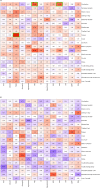The relationship between uremic toxins and symptoms in older men and women with advanced chronic kidney disease
- PMID: 35371454
- PMCID: PMC8967681
- DOI: 10.1093/ckj/sfab262
The relationship between uremic toxins and symptoms in older men and women with advanced chronic kidney disease
Abstract
Background: Patients with stage 4/5 chronic kidney disease (CKD) suffer from various symptoms. The retention of uremic solutes is thought to be associated with those symptoms. However, there are relatively few rigorous studies on the potential links between uremic toxins and symptoms in patients with CKD.
Methods: The EQUAL study is an ongoing observational cohort study of non-dialyzed patients with stage 4/5 CKD. EQUAL patients from Germany, Poland, Sweden and the UK were included in the present study (n = 795). Data and symptom self-report questionnaires were collected between April 2012 and September 2020. Baseline uric acid and parathyroid hormone and 10 uremic toxins were quantified. We tested the association between uremic toxins and symptoms and adjusted P-values for multiple testing.
Results: Symptoms were more frequent in women than in men with stage 4/5 CKD, while levels of various uremic toxins were higher in men. Only trimethylamine N-oxide (TMAO; positive association with fatigue), p-cresyl sulfate (PCS) with constipation and 3-carboxy-4-methyl-5-propyl-2-furanpropionic acid (negative association with shortness of breath) demonstrated moderately strong associations with symptoms in adjusted analyses. The association of phenylacetylglutamine with shortness of breath was consistent in both sexes, although it only reached statistical significance in the full population. In contrast, TMAO (fatigue) and PCS and phenylacetylglutamine (constipation) were only associated with symptoms in men, who presented higher serum levels than women.
Conclusion: Only a limited number of toxins were associated with symptoms in persons with stage 4/5 CKD. Other uremic toxins, uremia-related factors or psychosocial factors not yet explored might contribute to symptom burden.
Keywords: CKD; elderly; symptoms; uremic toxins.
© The Author(s) 2021. Published by Oxford University Press on behalf of the ERA.
Figures



Similar articles
-
Association between Dental Scores and Saliva Uremic Toxins.Toxins (Basel). 2023 Nov 20;15(11):666. doi: 10.3390/toxins15110666. Toxins (Basel). 2023. PMID: 37999529 Free PMC article.
-
Cognitive Function and Uremic Toxins after Kidney Transplantation: An Exploratory Study.Kidney360. 2020 Sep 21;1(12):1398-1406. doi: 10.34067/KID.0000272020. eCollection 2020 Dec 31. Kidney360. 2020. PMID: 35372897 Free PMC article.
-
Does the Administration of Sevelamer or Nicotinamide Modify Uremic Toxins or Endotoxemia in Chronic Hemodialysis Patients?Drugs. 2019 Jun;79(8):855-862. doi: 10.1007/s40265-019-01118-9. Drugs. 2019. PMID: 31062264 Clinical Trial.
-
Uremic Toxin Clearance and Cardiovascular Toxicities.Toxins (Basel). 2018 Jun 2;10(6):226. doi: 10.3390/toxins10060226. Toxins (Basel). 2018. PMID: 29865226 Free PMC article. Review.
-
Protein-bound uremic toxins (PBUTs) in chronic kidney disease (CKD) patients: Production pathway, challenges and recent advances in renal PBUTs clearance.NanoImpact. 2021 Jan;21:100299. doi: 10.1016/j.impact.2021.100299. Epub 2021 Jan 28. NanoImpact. 2021. PMID: 35559786 Review.
Cited by
-
Sweet, bloody consumption - what we eat and how it affects vascular ageing, the BBB and kidney health in CKD.Gut Microbes. 2024 Jan-Dec;16(1):2341449. doi: 10.1080/19490976.2024.2341449. Epub 2024 Apr 30. Gut Microbes. 2024. PMID: 38686499 Free PMC article. Review.
-
Associations Between Uraemic Toxins and Gut Microbiota in Adults Initiating Peritoneal Dialysis.Toxins (Basel). 2025 Jul 1;17(7):334. doi: 10.3390/toxins17070334. Toxins (Basel). 2025. PMID: 40711145 Free PMC article.
-
Pediatric and adult point of view on the gut-kidney axis in CKD.Pediatr Nephrol. 2025 Jul 7. doi: 10.1007/s00467-025-06780-8. Online ahead of print. Pediatr Nephrol. 2025. PMID: 40622577 Review.
-
Biotics (Pre-, Pro-, Post-) and Uremic Toxicity: Implications, Mechanisms, and Possible Therapies.Toxins (Basel). 2023 Sep 4;15(9):548. doi: 10.3390/toxins15090548. Toxins (Basel). 2023. PMID: 37755974 Free PMC article. Review.
-
Liquid Chromatography-Mass Spectrometry Analytical Methods for the Quantitation of p-Cresol Sulfate and Indoxyl Sulfate in Human Matrices: Biological Applications and Diagnostic Potentials.Pharmaceutics. 2024 May 30;16(6):743. doi: 10.3390/pharmaceutics16060743. Pharmaceutics. 2024. PMID: 38931865 Free PMC article. Review.
References
-
- Murphy EL, Murtagh FEM, Carey I et al. Understanding symptoms in patients with advanced chronic kidney disease managed without dialysis: use of a short patient-completed assessment tool. Nephron Clin Pract 2009; 111: c74–c80 - PubMed
-
- van de Luijtgaarden MWM, Caskey FJ, Wanner C et al. Uraemic symptom burden and clinical condition in women and men of ≥65 years of age with advanced chronic kidney disease: results from the EQUAL study. Nephrol Dial Transplant 2019; 34: 1189–1196 - PubMed
-
- Voskamp PWM, Van Diepen M, Evans M et al. The impact of symptoms on health-related quality of life in elderly pre-dialysis patients: effect and importance in the EQUAL study. Nephrol Dial Transplant 2019; 34: 1707–1715 - PubMed
-
- Vanholder R, De Smet R, Glorieux G et al. Review on uremic toxins: classification, concentration, and interindividual variability. Kidney Int 2003; 63: 1934–1943 - PubMed
Grants and funding
LinkOut - more resources
Full Text Sources
Miscellaneous

